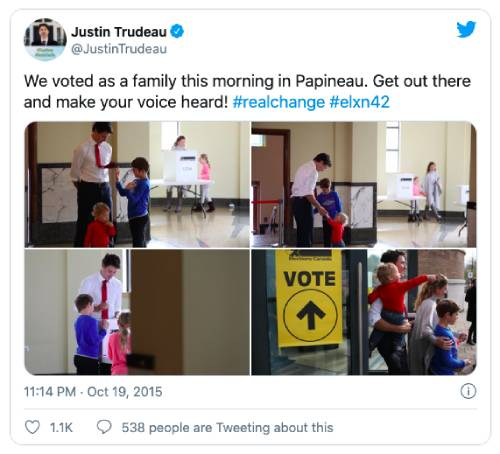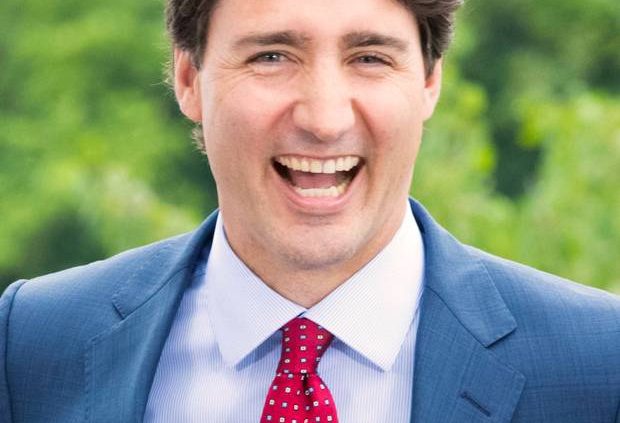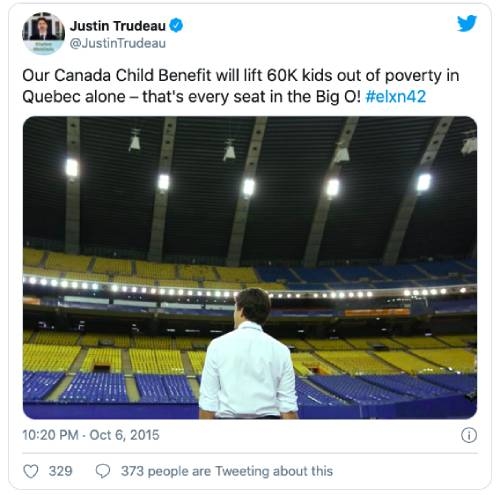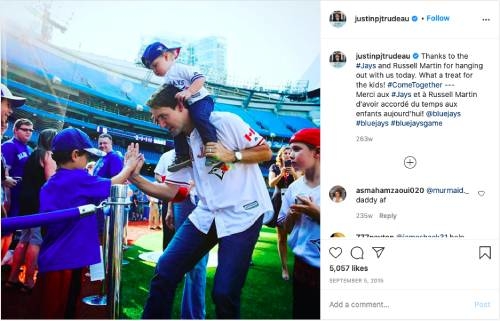Landslide Victory for Justin Trudeau | New Political Marketing Strategies
Many regard Barack Obama to be the pioneer of digital marketing for political purposes. Then, Donald Trump surfaced and used the same platforms.
Obama introduced new marketing strategies to disseminate information to the public and to conduct fundraising for his campaign. While Trump, the current POTUS, is widely known for using Twitter. He often tweets outrageous messages to his massive following in the millions, among other strategies.
Enough of American politics. As we travel not far to neighboring Canada, we also observe similar digital marketing behavior. In Canada, Justin Trudeau heavily relies on social media for his own political agenda. Elected as the Prime Minister of Canada on October 19, 2015, Trudeau is exceptionally active on Instagram. He uses this platform to communicate with his audience visually.
After breaking records as the most extended campaign in the past century, the Liberals were victorious during the federal election. They won more than half of the seats and the majority of the popular vote. It was a solid performance giving them a powerful stance in the government.
Trudeau’s success has been attributed to his campaign performance as well as his televised debates. As we break down the young prime minister’s strategies, we notice that political marketing is heading towards significant and noticeable changes. Gone are the days of traditional media as we see less and less usage. With politicians actively campaigning on these new digital platforms, it’s beginning to set a new trend in political communication.
Here is a list of activities and strategies carried out by Team Trudeau helping him to win the 2015 election
1. Social Media Strategy
Beating his competition at video marketing
Studying the strategies of all candidates, there were similarities shared as well. Other candidates also utilized video marketing on social media platforms. However, Trudeau beat them in terms of creativity and messaging. Most of his videos were 6-30 seconds long. They were short, to the point, and caught the attention of the audience. His content was widely shared and retweeted.
On top of that, he also mixed humor into the plot. From speeches to cartoons, his videos were not the conventional or serious type. In the video below titled ‘Different hair, same platform’, it outlines the plans of the Liberal party. At the same time, it also takes digs at different hairstyles.
Connecting with the people on a deeper level
One of Trudeau’s main goals is to connect with his audience and make them feel like they are a part of his team. Using hashtags such as #GenerationTrudeau and #RealChange, the young prime minister had his audience feeling like they were making a change together.
Months before his campaign kicked off, he was aware that to reach Canadians, he had to go online and connect with them. He couldn’t just rely on press releases and conventional methods. He knew that his content had to be more diverse than just political matters, which is why he didn’t only post about policies and government changes. A lot of his tweets focused on emotional appeal. Instead of telling people what he would do, he focused on why he was doing it.
Positioning himself as a family man
Besides focusing solely on politics, he also won the hearts of Canadians by revealing that he was a family man. Trudeau allowed the audience to come behind the scenes by giving them a glimpse into his family life. This covered tweets of wishing his late father a happy birthday to celebrating his son’s eighth birthday. Through these “family man” tweets, he positioned himself as a caring father, husband, and son.

Reaching out and engaging with Canadians on multiple social media platforms
It’s not just about consistently posting on social media platforms. Another critical component is engagement. Team Trudeau replied and engaged with his online audience. These actions showed that they weren’t only disseminating information to the public; they were also listening. Furthermore, all posts were published in English and French to accommodate the two most spoken languages in Canada.
Trudeau was able to propel his personal appearance and social media presence while other candidates only focused on the first part. Even after he won the election, he continued his social media practices. To this day, he continues to reach out and engage with Canadians on major social networking platforms.
Today his Instagram account has amassed a 3.8 million following with a total of 1,403 posts.
2. Ads: Creative point of view
When you hear the words political advertising, you might think about only political topics and a more direct approach. However, Team Trudeau wanted to do things differently. Instead of the usual dry content, they wanted to have a creative point of view. The whole idea was to have the ads not looking or feeling like political advertising.
The ad concepts were the brainchild of his advisors, Gerald Butts and Katie Telford, and other members of the campaign team. Team Trudeau also worked together with an agency. It was Bensimon Byrne who wrote the ads, designed the look, and directed the shoots. At the time, the campaign was led by partner and chief creative officer David Rosenberg of Bensimon Byrne.
“They worked on concepts that we developed together. David would take them away and make the creative presentation incredible,” Mr. Butts said.
Following the campaign, Rosenberg shared which ads he thought had the most significant impact on the campaign, as well as how they came about.
Ready
Released in the summer, this ad followed Trudeau walking on Parliament Hill. During his walk, he brought up the ads of the opposing party that had constructed him as “just not ready”. Retaliating against the Conservatives, the script crafted for Trudeau had him saying that he was ‘not ready for an economic recession or job losses’.
“There’s a rule that you’re not supposed to parrot the language your opponents are using against you – an accepted rule of political advertising,” Mr. Rosenberg said. “I said, ‘I think it’s time to break some rules here.’ By taking that criticism head-on, we were able to begin to change people’s perceptions.”
After it aired, the ad gained popularity and continued playing up until the election. Trudeau also showed toughness and that he was willing to respond to the claims of his opposition. He was willing to put up a good fight and refused to accept any personal attacks. No one wants a weak prime minister.
Escalator – Harder to Get Ahead
In this ad, the leader of the Liberals is seen walking up a downward moving escalator. The ad is not about the escalator. It is a metaphor describing how Canadians have been stuck on their downward escalators for ten years under Stephen Harper. And against such a strong force, they will eventually make it to the top. Check out the video here:
“To make the point to the visual metaphor, was a risk for him,” Mr. Rosenberg said. “He put himself out there in such a unique way. It’s a set piece.”
“Do I look scared to you?”
In this ad, it features former Mississauga mayor and powerhouse Hazel McCallion. She agreed to star in this ad to combat more claims made by the Conservatives. Trudeau’s opposition had claimed that he would cancel income splitting for seniors.
McCallion is seen responding to the claims. She counters with, “Stephen Harper isn’t telling the truth saying Justin Trudeau will cancel income splitting for seniors. It’s like one of those phone scams seniors get because Harper thinks we’re scared. Trudeau will also restore old age security back to 65, that’s up to $30,000 more for seniors. Stephen: Do I look scared to you?”
3. Viral potential
As we continue to break down Trudeau’s strategies and study the content he publishes, we notice that he knows how to create powerful moments with high viral potential. He has mastered the art of creating moments that spread like fire on traditional and social media.
Let me list an example of his mastery. After a landslide election victory, the next morning, Trudeau made an appearance at a local metro station in Montreal. He showed up without a security detail, nor was he dressed formally. Why did he show up there? To thank voters. The astonishing thing about this event was that he did not inform the press. It turns out that only a few members of the media actually knew.
It was intentional. Trudeau didn’t want it to come off as a planned activity. Team Trudeau thought that if he showed up unexpectedly, the public would be surprised to see their newly elected prime minister shaking hands with strangers. And that this would spread like fire throughout social media.
They were right. The new prime minister made an appearance in a place that would be an ordinary citizen’s commute. It was indeed a surprise and everyone loved it. It also portrayed Trudeau as warm and charismatic, unlike his predecessor. The former prime minister had always been known to be unapproachable and distant.
Similarly, his team planned quite a surprise for his swearing-in ceremony as well. Check out the video below:
Politicians often overlook moments. But not Trudeau’s team. They knew how to take advantage of the situation. For his swearing-in ceremony, Trudeau arrived on foot together with his diverse and inclusive cabinet. Not only that, the public was encouraged to participate in the ceremony. They were allowed to gather and interact with the media.
Clearly, Justin Trudeau understands the magnitude of moments.
4. Random act: Making phone calls to random people
In line with how he likes to be involved in surprising acts, here’s another one. Approaching the next federal election, Team Trudeau came up with a new marketing technique: calling random people. And not calling just to say hi, but to have conversations on a variety of issues. Some of the calls have even gone up to half an hour long.
“While a lot of attention is being paid this month to the series of town-hall meetings that Trudeau is holding across Canada, these phone calls are a lesser-known method of trying to keep the prime minister in touch with people outside the political bubble. It’s really the opposite of mass communication — a form of niche marketing, you might say, by this prime minister.” – Susan Delacourt
This type of personal reach is not scalable, but he’s getting lots of points for connecting with the people. Most politicians choose to stay in their bubbles. The lack of interaction means that they lose the connection with ordinary joes on the street. They fail to understand that these citizens are also voters and have issues to be solved.
Connecting with people on a personal level is extremely important. If your voters are your “customers”, you need to be using creativity to get their attention. In today’s world, it might be a considerable challenge as your customers are bombarded with a ton of information.
Creativity is also related to embracing the unknown. As marketers, you need to have the courage to go out there and do things that others aren’t doing. To stand out, you’ll need to stop looking at your competition and try to kickstart a new concept.
Besides creativity and having a unique image, marketing is more than just grabbing attention. After you’ve managed the first part, the next thing to do is nurture your relationship with customers. Too many brands manage to catch some eyeballs, but fail to do more than that.
Many companies take their customers for granted. They think that once a lead becomes a customer, they’ll stick around forever. But these days, with so much competition, customers can quickly turn into non-customers. So when Trudeau does something like talk to someone for 30 minutes, he’s nurturing the relationship. He might not be able to call the entire nation, but people know that he’s making an effort to stay connected.
The 2015 election saw the highest turnout since 1993. 68.5% of the nation came out to vote. One of the main reasons was Trudeau’s campaigning efforts. He didn’t ask them to vote for him, but he wanted everyone to have a voice. His ability to connect and speak to the people motivated them to make an effort. At the same time, he also portrayed himself as a relatable candidate who was keen about dealing with their issues.
Before Canada had Trudeau as a candidate, other politicians relied heavily on photo-ops. Justin Trudeau proudly wields social media and moments. His actions are re-defining political marketing. With his success in this area, we will see more of this play out in the post-Trudeau era.
Community

Congratulations on reaching the end!
Check out our podcast Impact Talks, where you can listen to high-profile experts from various backgrounds!
Join our Facebook Group Community with over 4,700 entrepreneurs, innovators, and creators by Startup Funding Event, where you get access to free live training, daily Q&As, design templates to get your business started, and support from the SFE team. Join here!






Leave a Reply
Want to join the discussion?Feel free to contribute!